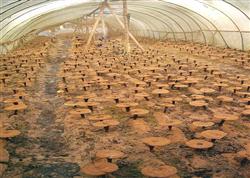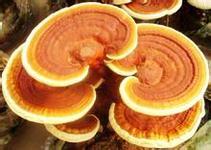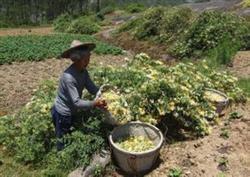Field covering soil imitating Wild cultivation techniques of Ganoderma lucidum

China is rich in Ganoderma lucidum, and its products are exported to Japan, South Korea, Singapore and Southeast Asian countries and regions, especially after China's entry into WTO, the domestic product demand and export volume will increase greatly, but in recent years, the wild resources of Ganoderma lucidum are decreasing day by day due to the massive felling of wood resources, so it is urgent to cultivate Ganoderma lucidum in a large area. The techniques of imitating wild cultivation of Ganoderma lucidum in Juancheng, Shandong Province for many years are introduced as follows: first, Ganoderma lucidum strains are purchased in the market, the vast majority of Ganoderma lucidum, Ganoderma lucidum. 2. Ganoderma lucidum is a high-temperature fungus in cultivation season, which produces Ganoderma lucidum at constant temperature. the optimum temperature for mycelial growth is 20-28 ℃ and the optimum temperature for fruiting body growth is 26-29 ℃. When the temperature was lower than 20 ℃ for a long time, the mycelium grew slowly and the fruiting body grew poorly or could not differentiate, while when the temperature was above 33 ℃, it was easy to rot and die. It is better to cultivate in April in North China, and other areas should be based on local temperature conditions. According to the biological characteristics of Ganoderma lucidum, we should choose a place with high terrain and smooth drainage. The shed requires heat preservation, moisturizing, good ventilation, appropriate amount of light, convenient operation and management. The materials for building the shed are bamboo poles, sticks and iron wire, etc., and can also be used locally. The size of the shed can be determined according to the number of cultivation, the size can be, the height of the shed is about 2m, leaving doors at both ends, and opening multiple vents around. The cultivated soil was disinfected 3-5 days before Ganoderma lucidum entered the shed. Lime powder can be used to strictly disinfect the border surface, and then turn the soil over and hoe. The depth of the border surface is consistent with the length of the bacterial bag. Fourth, it is better to use sawdust as culture medium for cultivation materials, and other raw materials should be tested before large-scale production. The following three formulations are introduced: 1. Sawdust 70%, wheat bran 24%, corn meal 3%, phosphate fertilizer 1%, gypsum powder 1.5%, sugar 0.5%. two。 50% corncob, 35% sawdust, 14% wheat bran, 14% rice bran, 1% gypsum powder. 3. 77% of cotton husk, 10% of wheat bran, 10% of corn meal, 1% of sugar, 1% of phosphate fertilizer and 1% of gypsum powder. Fifth, the sawdust production of cultivated materials should choose broad-leaved tree varieties, and sawdust such as pine, cypress, fir and camphor trees should not be used. In the preparation of cultivation materials, first mix cottonseed shell, sawdust, wheat bran, gypsum powder and other materials, then dissolve sucrose with water, turn the pile with water and mix it with water, with a water content of 60%-65%. Hold on to the water by hand without dripping or loosening, and you can pack the bag after mixing the material. The bag specification can be 15cm × 35cm × 0.05cm polypropylene or polyethylene barrel bag, each bag contains 350g / 500g dry material. The polyethylene bag material was sterilized under atmospheric pressure for 10 hours, and the polypropylene bag was sterilized under high pressure for 2 hours. The waiting material was cooled to less than 30 ℃ and transferred to a sterile box or aseptic room for inoculation. Fumigate and disinfect with formaldehyde and potassium permanganate before inoculation, turn on the ultraviolet light and keep it for 40 minutes, then inoculate under aseptic operation. Move the inoculated bag into the sterilized culture room and discharge it layer by layer, with the mouth of the bag facing outward, generally 6-8 stories high for every discharge. there should be a proper gap between the bag and the upper shelf to avoid burning the pile and damaging the bacteria due to the high temperature of the bag. 6. bacteria management during the culture period, the temperature of the culture room should be 26: 30 ℃, the air relative humidity should be 40%-65%, and the ventilation should be about half an hour every day. Check the bacterial bag every day. If the temperature of the bag is too high, turn the pile in time to keep the temperature of the bag balanced. When the mycelium grows in the bag 1 / 2 or 2 / 3, the bag should be properly oxygenated. The method is to use the sterilized needle tip to 1~2cm around the part of the mycelium that is full of mycelium, stick a few holes or tie the rope at the mouth of the bag, but it can not all be untied. After 25 or 30 days of culture, the mycelium can grow full bag and cover the soil in the shed. Seventh, the mycelium of Ganoderma lucidum covered with soil grew full bag and moved into the cultivation shed to refine the bacteria. When moving into the field, spread a layer of plastic film on the border or on both sides, put the bacterial bag flat on top, cover it with a plastic film or build a small arch shed, and keep it warm at about 25 ℃. After 3-4 days, cut the bacterial bag with a blade to remove the bacterial tube and lay flat, the action should be light and slow, so as not to damage the mycelium. Cover the film for heat preservation according to the previous requirements. After 3-5 days, a layer of lodging hyphae growing on the tube can form a skin and then cover the soil. Before covering the soil, the fungus tube is discharged upright, the row spacing is 10cm × 10cm, the soil is covered while discharging, the soil between the canister is filled, and the soil on the fungus surface is covered with 1~2cm. After covering the soil, a small arch shed is built on the border, which is like a vegetable seedling shed, and then the greenhouse is closed tightly. The temperature is kept at 25: 30 ℃, the air humidity is increased to 85% and 95%, and the sesame bud can grow after 5 days. When leaving Ganoderma lucidum, the temperature of the shed should be kept at 27: 30 ℃, the air humidity should be 90%-95%, and there is a certain amount of scattered light and sufficient oxygen. Ventilation should be carried out 2 times a day. When spraying water, the water should not be sprayed directly on the sesame bud. After 5-7 days, the primordium expands gradually to form a bacterial cap. After 2-3 weeks of growth, water can be sprayed on the cap, and the number of times of spraying water should be determined according to the temperature in the shed. After 55 days of management, the edge of the cap changed from white to yellow to black. After ejecting spore powder, the cap and stalk are hard, and the back of the cap changes from white to grayish brown, indicating that the fruiting body has matured and can be harvested. Eighth, harvest and postharvest management stop spraying water and close shed doors and vents 3-5 days before harvest. Cut off with a sharp knife from the base of the stalk about 2cm during harvest. If there are impurities such as soil on the surface of the cover, you can use a soft brush on the surface. Store or sell in a dry room. After Ganoderma lucidum harvest, stop spraying water for 2-3 days, increase the humidity by 90%-95%, and keep the temperature at 27-30 ℃. After 7-10 days, entities can continue to grow on the original stalk. According to the previous method, the second batch of Ganoderma lucidum can be harvested, and generally 3 batches can be harvested. Dry Ganoderma lucidum can produce 170-200g per kilogram of dry material.
- Prev

Medicinal value and cultivation techniques of Ganoderma lucidum
Ganoderma lucidum, also known as divine grass, ten thousand years grass, Ganoderma lucidum, Ganoderma lucidum, Ganoderma lucidum and so on. There are more than 40 kinds in China, and the more common and famous ones are Ganoderma lucidum, pine Ganoderma lucidum, black Ganoderma lucidum, Ganoderma lucidum and so on. Ganoderma lucidum has been used medicinally in China for more than two thousand years. In addition to containing potassium, phosphorus, magnesium, calcium, iron, manganese and other minerals.
- Next

Picking and processing skills of Flos Lonicerae
1. The time of picking flowers: the time of picking flowers is from 9 to 12:00 last year, which is not suitable for picking when there is dew and rainy days, and can also be picked if there is drying equipment. The green flower picked in the morning has the advantages of heavy white, easy drying, strong aroma, high commodity rate and good quality. The quality of flowers picked after noon and in cloudy days is poor, and the processing rate is low. From the process of flower development.
Related
- Fuxing push coffee new agricultural production and marketing class: lack of small-scale processing plants
- Jujube rice field leisure farm deep ploughing Yilan for five years to create a space for organic food and play
- Nongyu Farm-A trial of organic papaya for brave women with advanced technology
- Four points for attention in the prevention and control of diseases and insect pests of edible fungi
- How to add nutrient solution to Edible Fungi
- Is there any good way to control edible fungus mites?
- Open Inoculation Technology of Edible Fungi
- Is there any clever way to use fertilizer for edible fungus in winter?
- What agents are used to kill the pathogens of edible fungi in the mushroom shed?
- Rapid drying of Edible Fungi

